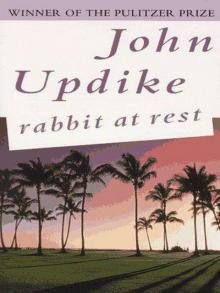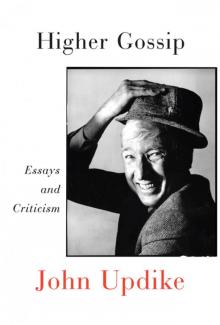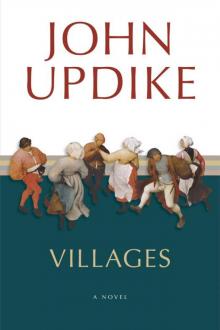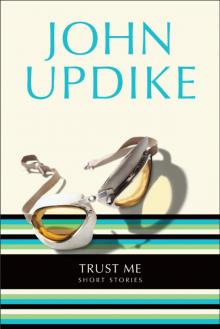- Home
- John Updike
Picked-Up Pieces: Essays Page 9
Picked-Up Pieces: Essays Read online
Page 9
Anguilla’s association with St. Kitts (St. Christopher) has always been tenuous. St. Kitts is the nearest British island, but lies seventy miles to the south, beyond St. Martin/Sint Maarten (French and Dutch), St. Bart’s (French), and Saba and Sint Eustatius (both Dutch). When, in 1796, a French force invaded Anguilla under orders to exterminate the English inhabitants (legend says the fishermen of Anguilla loaded their cannon with lead seine weights), help arrived not from St. Kitts but from more distant Antigua, in the form of the man-of-war Lapwing; the St. Kittians, to be fair, did address to the Lapwing commander a letter of thanks for his rescue of a “sister colony.” In Anguilla, the laws lay dormant for want of a magistrate, and not until after 1800 did the Anguillans send a representative to the St. Kitts legislature. In lieu of anarchy, the Anglican vestry ruled the island, headed by the parson and the warden; until very recently, the manager of the island’s rather minimal affairs has borne the proud title of Warden. The West Indian archives contain more than one instance of a colonial official’s shirking and bemoaning his assignment to Anguilla. “Indeed such an assignment,” one penned in 1842, “is but poor reward for a life devoted to the Service of the Crown.” In 1871, when the Federal Colony of the Leeward Islands, with its capital in Antigua, was created by Parliament, Anguilla expressed a desire not to be lumped with St. Kitts, but Governor Benjamin Pine, already sufficiently harassed by a plethora of presidencies under his government, ignored the request. During the Second World War, when St. Martin was a Vichy fuelling station for German submarines, American soldiers built an airstrip on Anguilla and impressed the Anguillans so favorably that as late as 1960 wistful hopes of an American takeover were still alive. One rumor claimed that the United States had offered to forgive Great Britain her entire lend-lease debt in exchange for Anguilla, and had been refused. Anguilla’s poor-sister status within the Leewards worsened after the St. Kitts–Nevis–Anguilla state was granted home rule. Anecdotes of the short shrift that Anguilla thereafter received from the Bradshaw government have the orotund ring of legend. For instance, when Great Britain requisitioned money for a much-needed pier on Anguilla, where anything bigger than a sack of wheat must be tediously rafted in, the St. Kitts government took the money and built the pier on its own island, christening it, deadpan, Anguilla Pier. School supplies and salaries for Anguillans were held up. Anguillan public-works projects—such as the planting of hundreds of unwired telephone poles along the roads—were carried forward with labor brought from St. Kitts. “Anguilla men go all over the islands looking for work,” our taxi-driver said, gesturing toward these poles. “Anguilla men know enough to build big boats and plant a sixty-foot mast when the boats sit in the water, but Anguilla men don’t know enough to dig a hole.” The St. Kittian policemen on Anguilla were not beloved. In March of 1967, their precipitate use of tear gas turned into a riot an intended demonstration at a potentially benign gathering—the contest to choose a Miss Anguilla to compete for the title of Miss Statehood. It is a parable of the slenderness of St. Kitts-Anguilla ties that when the revolution came, on May 30th last year, it consisted simply of rounding up the seventeen St. Kitts policemen, putting them into a boat, and pushing them out to sea.
Though everyone, including the Anguillans themselves, emphasizes the revolution’s comic-opera episodes, bloodshed was threatened, and there was no going back. On June 11th, gunmen attacked police headquarters in Basseterre; earlier that spring, fifty shots had been fired into the lodgings of a Warden sent from St. Kitts. On June 16th, Peter Adams, who had been Anguilla’s representative in the state legislature, proposed that the United States make Anguilla an American territory. His proposal was ignored in Washington. On July 11th, a popular referendum showed 1,813 to 5 for independence; Peter Adams was chosen president and asked for talks with President Johnson. Our President’s response, if any, did not make the newspapers. On August 1st, under the supervision of a Caribbean Commonwealth Conference in Barbados, a reconciliation was worked out whereby Anguilla ended its secession and Bradshaw promised greatly increased financial aid. On August 4th, Anguilla deposed Peter Adams and installed as president Mr. Ronald Webster, a member of the Seventh-Day Adventist Church, one of the wealthiest men on the island, and Adams’ Minister of Interior. Two days later, Jeremiah Gumbs went to the United Nations and told reporters, “The people are very aware about not losing control of their land.… We want to keep the island the way God made it.” By the middle of August, the frigate Lynx, with a contingent of British Marines, moored off Blowing Point but was warned by Webster that blood would flow if a landing was attempted. (One strange tale from this period of crisis is that some Marines did land, distributed candy to the children who had gathered, and were seen off by a band playing “God Save the Queen.”) By the end of August, Jamaica had refused to condone an expeditionary force from various islands that would put down the rebellion, and it became clear that Bradshaw lacked the military muscle to impose his will. On August 29th, the U.N. hearing ended, with no action advised, and a nebulous, nervous peace prevailed. Even now, an incoming tourist is sternly questioned as to what his “mission” might be, and one can see on the dirt runway of the airfield barrels and rolls of barbed wire to obstruct the landing of any planes other than the two-engine Aztecs that run daily shuttles to St. Martin and St. Thomas. Our first evening here, a British pleasure craft lowered a few female swimmers into Rendezvous Bay, and a carload of Anguillan militia rushed to investigate the invasion. Without doubt, Anguilla is under economic siege; the Bradshaw government has cut off even the island doctor’s salary, and the schools and public services are kept going by infusions of private money, including tens of thousands of dollars from the pocket of Ronald Webster himself. A young man held on suspicion of murder languishes in the island’s jail; not only is there no magistrate to hear his case but St. Kitts, which has the facilities to test the murder weapon for fingerprints, both refuses to do so and refuses to let the gun be examined on another island. The suspect’s story is typically bizarre for these bewitched times: he was walking with one hand on a girl and the other on his bicycle when suddenly she fell down dead, a bullet in her heart.
Anguilla is currently run by a seven-man council, headed by Webster, that was elected on October 17th. The island’s international status is suspended for a year under the so-called Interim Agreement forged in December by a delegation of two British Members of Parliament; under the agreement, the Anguillan government supposedly accepts the advice and counsel of a Parliamentary mission headed by Mr. Tony Lee, a distinguished veteran of the British Colonial Service and a graduate of the hard schools of Kenya and Aden. Mr. Lee, an intelligent, tall, faintly corpulent Englishman of the breed whose diffident persistence once imposed British order on a quarter of the globe, is possibly the most popular man on Anguilla. “NO COMMUNISM—NO GANGSTERISM!” proclaims a legend painted on a building next to the old Methodist church on Road Hill. “WE WANT BRITISH RULE AND DEMOCRACY. GIVE US BRITAIN!” After its initial appeal to the United States, Anguilla has placed its hopes for stability and protection upon the power that elsewhere in the world is liquidating the last scraps of its empire.
Lee’s task is not easy, nor is his role clear. Even if Great Britain wished to grant Anguilla perfect independence, it is powerless to do so, for by the terms of the creation of the St. Kitts–Nevis–Anguilla state it abdicated all control over the state’s internal affairs, which include secession. Lee is present on Bradshaw’s sufferance as well as on Webster’s, and his principal leverage in local affairs seems to be the threat to leave. As he drives about the island in his Morris Mini, the quality of the salutes he receives suggests that, in the eyes at least of the older Anguillans, who have lived most of their lives under the scarcely palpable rule of an appointed white Warden, Lee is the new Warden. But in fact Anguilla’s destiny rests in the hands of Anguillans, and Lee’s task may be to persuade them to take their destiny seriously.
A population of six thousand is the size of a small Americ
an town. Like small-town politics everywhere, Anguillan politics appears to an outsider an inscrutable tangle of personalities, old grudges, and bad habits. The island, for instance, is geographically divided into the East End and the West End, and white and mulatto East Enders dominated the drive for independence. Is this resented? Anguilla surely is one of the most color-blind places left in an increasingly racist world, but an egalitarian tolerance bred by centuries of colonial obscurity may well be strained by the opportunities and adversities of independence. And what of nepotism, where every third person is named Rey, Richardson, or Gumbs? We attended a political rally on the cricket field and heard a young man called Atlin Harrigan try to defend, under some vicious badgering, his newspaper, the Beacon, which had asked for new elections and an expanded council, and had implied graft and log-rolling in the present council. “I am in a fearful bind,” he said into the microphone, “for if I print half of what I know, I fear Bradshaw will use it to prove that Anguillans cannot govern themselves.” In turn, a council member, Mr. Wallace Rey, rose up and claimed that it was highly improper for the Beacon to be printed on the Anglican Church’s duplicator. This demand for separation of church and state strikes a rather new note on an island governed for generations as an adjunct of the Anglican Church, and may not be unrelated to the whiteness of the present rector. Although the crowd of several hundred acted much like any bored and amused small-town rally, two old ladies came to blows beneath a mahogany tree, and some of the speakers, including an urbane refugee from one of Bradshaw’s jails, seemed all too expertly demagogic. When the council secretary spoke suavely of the council’s right to secret discussion and of its wisdom of choice as to what “the people” should know, I myself, as children scampered around the mustered trucks in the tropic twilight, felt chilled by a whisper of Fascism. The crowd seemed puzzled and somewhat cynical, and voiced unity only at the mention of the hated name of Bradshaw, a bogey whose usefulness cannot be infinite.
The Anguillan national flag, designed by an American firm, shows three orange dolphins in a circle on a white field above a stripe of sea blue. The dolphins seem to be chasing each other around and around. If one of them is Tony Lee, the representative of empire, of Britain’s desire to salvage a colony she shaped, and another is Ronald Webster, the representative of independence, of Anguilla’s honorable heritage of self-reliance, the third might be Jeremiah Gumbs, the representative of enterprise, which can eat up the other two. Mr. Gumbs, an energetic, bearish man who had visited the island shortly before we arrived, was enterprising enough to leave Anguilla as a youth (he was born in 1913) and become a successful fuel-oil dealer in Edison, New Jersey. It was Jere Gumbs who hired as advocate and adviser the Harvard Law School professor Roger Fisher and, with him, took Anguilla’s case to the U.N. Assembly’s Special Committee on Colonialism. He owns the island’s only passably modern hotel, the Rendezvous Bay, which his sister Beatrice runs in a breezy American style. Jere Gumbs has also recently bought from the Lake family Dog Island, an uninhabited but sizable satellite island, where, rumor goes, he would like to construct a convalescent home. It was Jere Gumbs who, on his flying visit, restored to workability two of the five St. Kittian bulldozers confiscated in the revolution; it was also Jere Gumbs who arranged to rent these same bulldozers, at a price thought by some to be nominal, from the public-works department for the purpose of excavating a large cistern at his own hotel.
Anguilla needs but distrusts enterprise. A new resident in the community of nations is apparently subjected to a Welcome Wagon of international opportunists: after the American flag designers and the Swiss stamp printers, come the offers to float in a gambling casino, to set up a quickie-divorce and/or abortion haven, intermixed with a trickle of utopian anarchists and political scientists preparing studies of the mini-state. Foremost among the latter has been Dr. Leopold Kohr, of the University of Puerto Rico; an admirer of the Pennsylvania Amish, Dr. Kohr advocates a world of self-sufficient agricultural villages. A San Francisco group interested in copping out of the 20th-century nexus of Realpolitik was actively fascinated by Anguilla last summer; they placed in The New York Times a slick full-page ad written by one of their number, Mr. Howard Gossage, an advertising man, asserting that Anguilla “does not want to become a nation of busboys” and impetuously offering honorary citizenships at a hundred dollars a head. More recently, a young hippie couple, penniless but equipped with a shotgun and several cameras, set up a tent on the beach near Shaddick Point and begged food from a wealthy American woman who has built a home there; after several weeks of this idyll, they were expelled back to St. Martin. Anguilla has thus far defended herself from these crude assaults, but any defense of virginity runs the risk of altogether succeeding, “ANGUILLA has been DELIBERATELY RETARDED,” reads a sign nailed up on a cement-block shed near Rendezvous Bay, and the question that hovers over the island’s scruffy pastures and empty beaches and minuscule taverns named Amity and Sea View and Lonely Valley and United Nation is how to bring Anguilla into the present without destroying the charm and virtue of its tardiness.
Tony Lee, in the interim year of grace, would like to see the roads improved and telephone service inaugurated, and has called in a United Nations planner to survey the island. He described to me the Christmas holidays, when over two thousand Anguillan men returned from St. Thomas and other unretarded islands, and dances were held all over Anguilla; “It’s their place, you see; there aren’t any big hotels they aren’t allowed into. I don’t know, it may be airy-fairy of me, but I think it would be nice somehow, if one could, to keep it, you know, their place.” Ronald Webster, a tea-colored man with the trim, stiff carriage of a self-taught schoolteacher, speaks of ten or more small hotels, one at each beach, and of Anguilla’s supporting a population larger than that of St. Thomas. He gives native industry priority over the tourist trade, but though there is a young furniture factory, and an American has set up a tiny shop for the manufacture of trinket jewelry, and two indigenous airlines are operating (despite a mysterious case of arson that grounded one plane), it is difficult to imagine any appreciable industry that would not have to import all its raw materials—to an island without a pier. Nor is the limbo status of the present government, while Bradshaw in Basseterre waits for Anguilla to prove unviable, likely to attract much investment capital. Americans hoping to acquire a cheap spot in the sun will be discouraged by the high value that the “peasant proprietors” place on their land. “This is paradise,” Ronald Webster said to me, with a quick, wicked smile, “and paradise is not cheap.” What Jeremiah Gumbs thought was expressed by the roaring and growling of the bulldozers as they slowly scraped a long hole in the coral earth beside our room at the Rendezvous Bay Hotel. By the end of a week, one bulldozer had sprung a tread and, after futile attempts to lift it with an automobile jack, stood mired in the pit it had dug. On the other bulldozer, one of the two cables supporting the front blade had snapped. Ronald Webster thought that the first dozer had merely lost a pin; so the concern of the Anguilla Department of Public Works, and of a displeased Tony Lee, and, behind him, of the British government (two British radio operators were daily exchanging messages with Whitehall), and, behind that, of the brooding American hemispherical over-presence on guard against a mini-Cuba, all danced for the moment on a pin lost in the dust.
And meanwhile the patient goats are tethered to the bushes of maiden-berry, and the sun beats down, and the Methodist churches thrive, and any tourist willing to jet from the mainland to St. Martin and stay overnight in Marigot or Philipsburg and take the next morning’s more-or-less-ten-o’clock, ten-minute, five-dollar flight to Anguilla’s dollhouse airport can experience, as did I and my wife, the aboriginal luxury of walking barefoot along miles of soft white coral sand and encountering no footprint but one’s own of the day before. It will not last forever. Transistor radios are creeping into Anguilla, conveying the Top Forty hits in the U.S.A. by way of Radio Antilles in Montserrat, and a few Americans and an Irish airline pilot have bu
ilt permanent vacation homes, and Anguillans who travel, like Mr. Émile Gumbs, say that now strangers nod knowingly when told you are from Anguilla: they have heard of it. Progress will come—these are the finest undeveloped beaches in the Caribbean—but slowly, resisted, one feels, by the instincts of the Anguillans themselves. The crowd at the political rally make a happy, erect impression in their Sunday suits and chiffon dresses, with an occasional miniskirt and a few motorcyclists—the impression of a colored population free, for this interim, of anger and shame. In the West Indies as a whole, these “islands in the sun” whose history is so scored with slaughter (the first modern genocide was committed by the Spaniards on the Arawaks), with the oppression of slaves and the rebellions of slaves, with piracy and massacre and cruelty—with the rage, in short, that seems to afflict Europeans whenever they leave their own ugly climate—one now feels a benevolent remove from world conflicts and a precious possibility: the possibility that blacks, torn as slaves from their African tribes and roughly implanted with Western languages and traditions, can now construct a fresh society. One goes to the Caribbean not only for the sun but for a tone—the tone of a culture based upon negritude but as different from that of the American Negro as the blues and the desperate joy of jazz are from calypso wit and the translucent pealing of the steel band. The large number of slave revolts in the islands, as opposed to their remarkable rareness on the North American continent, is an index of how much more demoralizing our subjugation was, and how much more durable its bad effects will be. Integration in the United States must be primarily an act of the white majority; in the Caribbean, where the majority is black, integration feels closer. A backwater like Anguilla, where black and white settlers were bound together in a fraternity of poverty, seems to offer a chance of skipping several nightmare chapters of race relations and of moving rather promptly into the polyracial future.

 Picked-Up Pieces: Essays
Picked-Up Pieces: Essays Bech: A Book
Bech: A Book Roger's Version: A Novel
Roger's Version: A Novel Seek My Face
Seek My Face The Carpentered Hen
The Carpentered Hen Pigeon Feathers: And Other Stories
Pigeon Feathers: And Other Stories Rabbit Is Rich
Rabbit Is Rich The Afterlife: And Other Stories
The Afterlife: And Other Stories Rabbit at Rest
Rabbit at Rest The Witches of Eastwick
The Witches of Eastwick Gertrude and Claudius
Gertrude and Claudius Bech Is Back
Bech Is Back Hub Fans Bid Kid Adieu: John Updike on Ted Williams
Hub Fans Bid Kid Adieu: John Updike on Ted Williams Marry Me: A Romance
Marry Me: A Romance Museums and Women: And Other Stories
Museums and Women: And Other Stories My Father's Tears and Other Stories
My Father's Tears and Other Stories Collected Poems, 1953-1993
Collected Poems, 1953-1993 Trust Me: Short Stories
Trust Me: Short Stories Odd Jobs: Essays and Criticism
Odd Jobs: Essays and Criticism Rich in Russia
Rich in Russia Higher Gossip: Essays and Criticism
Higher Gossip: Essays and Criticism The Widows of Eastwick
The Widows of Eastwick In the Beauty of the Lilies
In the Beauty of the Lilies Rabbit, Run
Rabbit, Run The Early Stories: 1953-1975
The Early Stories: 1953-1975 Rabbit Redux
Rabbit Redux S.
S. Brazil
Brazil Toward the End of Time
Toward the End of Time The Centaur: A Novel
The Centaur: A Novel Assorted Prose
Assorted Prose Memories of the Ford Administration
Memories of the Ford Administration Terrorist
Terrorist Couples: A Novel
Couples: A Novel Bech at Bay
Bech at Bay The Music School: Short Stories
The Music School: Short Stories Villages
Villages S
S Roger's Version
Roger's Version Pigeon Feathers
Pigeon Feathers Higher Gossip
Higher Gossip Rabbit Redux r-2
Rabbit Redux r-2 Memories of the Ford Administration: A Novel
Memories of the Ford Administration: A Novel The Centaur
The Centaur Marry Me
Marry Me Picked-Up Pieces
Picked-Up Pieces Bech
Bech Rabbit Remembered
Rabbit Remembered Trust Me
Trust Me The Early Stories
The Early Stories Odd Jobs
Odd Jobs The Centaurus
The Centaurus The Afterlife
The Afterlife The Music School
The Music School Museums and Women
Museums and Women Couples
Couples